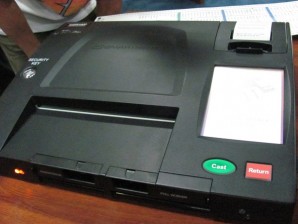MANILA, Philippines–The Commission on Elections (Comelec) is leaning toward using a combination of “old and new” machines for the 2016 national elections after Malacañang rejected the budget it requested for an “integrated system.”
The Comelec preferred the integrated system to avoid complications, and had asked for a budget of P16 billion for the elections in the proposed P2.6 trillion 2015 national budget, Comelec commissioner Christian Robert Lim told lawmakers on Thursday.
But the Department of Budget and Management (DBM) only allotted it P10.3 billion, so the Comelec has no choice but to work within this budget, Lim told the joint congressional oversight committee on the automated election system.
Still usable PCOS
According to Lim, the Comelec could still use 80,000 of the old precinct count optical scan (PCOS) machines and 6,000 brand-new ones. Including the cost of the printing of ballots and purchase of ballot boxes, the total cost would come to P6.9 billion, he said.
“We really have to consider using the old with some few new so that it fits into our budget,” Lim said in an interview after the hearing chaired by Sen. Aquilino Pimentel III and Samar Rep. Mel Sarmiento.
“It’s not official yet, but it looks that way,” he said.
The Comelec would decide which technology to use on Aug. 26.
According to Lim, the new PCOS machines would likely be used in select areas in Metro Manila, and the old ones in the rest of the country.
Mixed technology
The Comelec Advisory Council (CAC) has recommended that the Comelec use mixed technologies and reuse existing optical mark reader technology for the 2016 polls to ensure prudent spending, a recommendation that jibed with the DBM’s position.
The PCOS machines use the OMR technology.
Former Comelec commissioner Gus Lagman, convenor of the Transparent Elections watchdog group, wondered why the government would spend billions of pesos to speed up counting by half a day.
After all, in the May 2013 elections automated canvassing, aided by personal computers, laptops and servers, cut down the election process from six weeks to one, he said.
“Why should the Comelec, why should the government spend billions of pesos to shorten the election process by a mere half day?” Lagman said.
“What shortened the process from six weeks down to one was the automation of canvassing… PCOS only contributed half a day,” he said.
The Comelec would have needed a minimum P12 billion to buy 86,000 brand new OMR machines, or an integrated system for the 2016 polls.
Integrator needed
By combining old and new machines, it would need an integrator. In addition, it would conduct two separate trainings and issue two general instructions for the board of election inspectors (BEIs), Lim said.
“If you have a bigger budget, you have more flexibility,” Lim added.
Caloocan Rep. Edgar Erice said the committee could help convince the Executive Branch to grant the requested P16 billion so the Comelec could use brand new machines.
“If we’re given money, why not use something new?” Comelec Chair Sixto Brillantes said at the hearing. But he acknowledged that the government could save money by using the old PCOS machines.
Brillantes said that the Comelec steering committee, headed by Lim, had been meeting regularly to prepare for the May 2016 elections.
“Everything is prepared. We’re just waiting for the money. If we’re given the necessary funding, we will be able to run the elections smoothly,” he said.
“They [the Comelec] will be able to run the elections smoothly,” said Brillantes who retires in February 2015.
